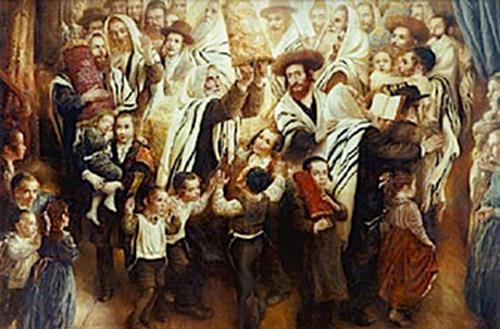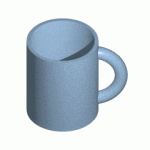Why is this night different from all other nights, asks a child on the Seder night. On this Simchat Torah I asked a different question—why is the day different from the night? Indeed, on the night of Simchat Torah, we dance seven hakafot-circuits. However, during the morning service of the next day, we only dance three-and-a-half hakafot. What is the meaning of this number—three and a half? There are a few instances the Torah, Talmud, and Rabbinic instances where this number is mentioned (e.g., during the Gaonic period, c. 590–1000 CE, in some communities in the Land of Israel, the Torah reading cycle was completed in three and a half years; Maimonides rules that only half of the tzitzit string should be dyed blue leaving three and a half strings white), but none of them seem relevant. Seven hakafot, as it is explained in the books of Kabbalah and Chasidic philosophy, represent seven midot—seven lower sephirot. However, what could possibly be the meaning of three and a half? Nobody I asked knew the answer, and this question was cycling in my head while we all were cycling around the bimah. Finally, while being thoroughly inebriated, it hit me.
The Temple Menorah requires three and a half lugim (lug is a measure of volume about a half-liter, lugim is pl. of lug) of olive oil. There is nothing special about the number three and a half per se. Each lamp of the menorah requires a half-lug of oil, which yields three-and-a-half lugim when multiplied by seven. So it is here: the point is not three-and-a-half hakafot—instead of doing a complete circuit around the bimah for each hakafa, in the morning we only do half-circuit per hakafa. The hakafot in the morning are done one after another with no interruption for dancing in between. Two half-circuits make up one complete circuit. After doing six hakafot, we complete three full circuits with one half-circuit left for the seventh hakafa. Thus the difference between evening and morning hakafot is the full circuit vs. half-circuit per hakafa. What is the symbolism of half-circuit and a full circuit?
Topology is a branch of mathematics that studies intrinsic properties of figures and space that do not change under continuous transformation, such as stretching or bending, so long as there is no tearing or gluing. Thus, topologically speaking, there is no difference between a perfect circle and an ellipse, which is circle slightly squashed in the middle. A mug is topologically equivalent to a donut.
Similarly, in topology, there is no difference between a curve and a straight line, because any curve can be straightened out without tearing it. An arc representing a semi-circle is topologically equivalent to a straight line of the same length. So, topologically speaking, what we have in the morning hakafot are two symbols: a circle and a line. This symbolism is highly significant to our conception of time.
The ancient Greeks (as well as other pagan cultures including Babylonians, Hindus, Mayan, and Native Americans) believed in a cyclical time (or the “Wheel of Time”). For them, the world always existed and would exist in perpetuity with all events repeating in a cycle.

Christians also believed in the creation of the world and messianic redemption and borrowed the Jewish notion of progress. In doing so, however, Christian theologians lost the cyclical aspect of time replacing it by a straight line from the Creation till the End of Days.
Whereas the Greek symbolism for time was a circle, and the Christian symbolism was a straight line, the Jewish metaphor for time is a spiral—a forward movement with a cyclical periodicity.
If you put together a line and a circle, you get a spiral—the Jewish metaphor for time. This is the meaning of the three-and-a-half hakafot on the morning of Simchat Torah. Full circuits and half-circuit make up the spiral of time.

This year, the Simchat Torah was followed immediately by Shabbat Bereshit, when we begin the new annual cycle of reading the Torah. It is called Shabbat Bereshit because the first word of the Torah is “Bereshit”—”in the beginning.” However, Shabbat Bereshit can also be translated as the Shabbat of Beginning. How appropriate, I thought, was that we finish the holiday of Sukkot with Simchat Torah when we put together the cyclical and forward-moving elements of time just before Shabbat Bereshit, when we begin the new cycle of time, each year on a higher level than before.
Here is to new beginnings. May we always move forward and upward!


